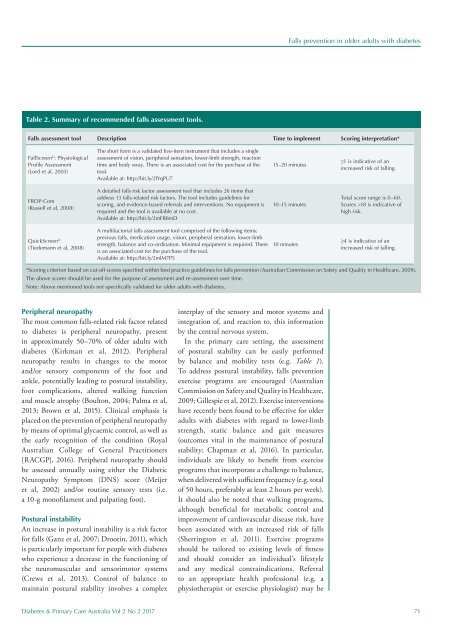DPCA2-2_issue_v3
Create successful ePaper yourself
Turn your PDF publications into a flip-book with our unique Google optimized e-Paper software.
Falls prevention in older adults with diabetes<br />
Table 2. Summary of recommended falls assessment tools.<br />
Falls assessment tool Description Time to implement Scoring interpretation*<br />
FallScreen © : Physiological<br />
Profile Assessment<br />
(Lord et al, 2003)<br />
The short form is a validated five-item instrument that includes a single<br />
assessment of vision, peripheral sensation, lower-limb strength, reaction<br />
time and body sway. There is an associated cost for the purchase of the<br />
tool.<br />
Available at: http://bit.ly/2lYqPU7<br />
15–20 minutes<br />
≥1 is indicative of an<br />
increased risk of falling.<br />
FROP-Com<br />
(Russell et al, 2008)<br />
A detailed falls risk factor assessment tool that includes 26 items that<br />
address 13 falls-related risk factors. The tool includes guidelines for<br />
scoring, and evidence-based referrals and interventions. No equipment is<br />
required and the tool is available at no cost.<br />
Available at: http://bit.ly/2mFR8mD<br />
10–15 minutes<br />
Total score range is 0–60.<br />
Scores >18 is indicative of<br />
high risk.<br />
QuickScreen ©<br />
(Tiedemann et al, 2008)<br />
A multifactorial falls assessment tool comprised of the following items:<br />
previous falls, medication usage, vision, peripheral sensation, lower-limb<br />
strength, balance and co-ordination. Minimal equipment is required. There<br />
is an associated cost for the purchase of the tool.<br />
Available at: http://bit.ly/2mlM7P5<br />
10 minutes<br />
≥4 is indicative of an<br />
increased risk of falling.<br />
*Scoring criterion based on cut-off scores specified within best practice guidelines for falls prevention (Australian Commission on Safety and Quality in Healthcare, 2009).<br />
The above scores should be used for the purpose of assessment and re-assessment over time.<br />
Note: Above mentioned tools not specifically validated for older adults with diabetes.<br />
Peripheral neuropathy<br />
The most common falls-related risk factor related<br />
to diabetes is peripheral neuropathy, present<br />
in approximately 50–70% of older adults with<br />
diabetes (Kirkman et al, 2012). Peripheral<br />
neuropathy results in changes to the motor<br />
and/or sensory components of the foot and<br />
ankle, potentially leading to postural instability,<br />
foot complications, altered walking function<br />
and muscle atrophy (Boulton, 2004; Palma et al,<br />
2013; Brown et al, 2015). Clinical emphasis is<br />
placed on the prevention of peripheral neuropathy<br />
by means of optimal glycaemic control, as well as<br />
the early recognition of the condition (Royal<br />
Australian College of General Practitioners<br />
[RACGP], 2016). Peripheral neuropathy should<br />
be assessed annually using either the Diabetic<br />
Neuropathy Symptom (DNS) score (Meijer<br />
et al, 2002) and/or routine sensory tests (i.e.<br />
a 10-g monofilament and palpating foot).<br />
Postural instability<br />
An increase in postural instability is a risk factor<br />
for falls (Ganz et al, 2007; Drootin, 2011), which<br />
is particularly important for people with diabetes<br />
who experience a decrease in the functioning of<br />
the neuromuscular and sensorimotor systems<br />
(Crews et al, 2013). Control of balance to<br />
maintain postural stability involves a complex<br />
interplay of the sensory and motor systems and<br />
integration of, and reaction to, this information<br />
by the central nervous system.<br />
In the primary care setting, the assessment<br />
of postural stability can be easily performed<br />
by balance and mobility tests (e.g. Table 1).<br />
To address postural instability, falls prevention<br />
exercise programs are encouraged (Australian<br />
Commission on Safety and Quality in Healthcare,<br />
2009; Gillespie et al, 2012). Exercise interventions<br />
have recently been found to be effective for older<br />
adults with diabetes with regard to lower-limb<br />
strength, static balance and gait measures<br />
(outcomes vital in the maintenance of postural<br />
stability; Chapman et al, 2016). In particular,<br />
individuals are likely to benefit from exercise<br />
programs that incorporate a challenge to balance,<br />
when delivered with sufficient frequency (e.g. total<br />
of 50 hours, preferably at least 2 hours per week).<br />
It should also be noted that walking programs,<br />
although beneficial for metabolic control and<br />
improvement of cardiovascular disease risk, have<br />
been associated with an increased risk of falls<br />
(Sherrington et al, 2011). Exercise programs<br />
should be tailored to existing levels of fitness<br />
and should consider an individual’s lifestyle<br />
and any medical contraindications. Referral<br />
to an appropriate health professional (e.g. a<br />
physiotherapist or exercise physiologist) may be<br />
Diabetes & Primary Care Australia Vol 2 No 2 2017 71
















